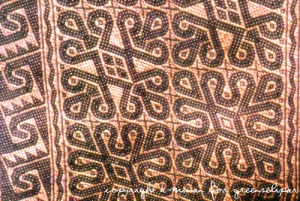 Mat-making is a skill known to every Borneo society. The rainforest abounds in suitable raw materials: reeds, leaves, barks or rinds. These ever-renewable fibres were fashioned into mats for everyday use; until the early 20th century few longhouse dwellers had furniture other than maybe a storage chest inside their family rooms. Sitting, eating, sleeping was done on the floor, on mats.
Mat-making is a skill known to every Borneo society. The rainforest abounds in suitable raw materials: reeds, leaves, barks or rinds. These ever-renewable fibres were fashioned into mats for everyday use; until the early 20th century few longhouse dwellers had furniture other than maybe a storage chest inside their family rooms. Sitting, eating, sleeping was done on the floor, on mats.
One fast-growing plant found mostly in the brackish coastal swamps, Pandanus spp, is a very popular mat-making material. Pandan mats are sometimes considered to be ‘Malay mats’, though other ethnic groups are equally skilled at making them if they can get the material.
Pandan mats are not quite as durable as the bemban product (see Iban Sleeping Mats), but they’re softer, and they are much more pliable. Besides spreading them for sitting and sleeping on, pandan mats were generally used to wrap articles – this included bodies readied for burial in the past! – to make temporary awnings or rain shelters, to quickly run up an interior wall in a house, to cover the slimy floorboards of a boat if important passengers were expected.
The pandan mats available in Sarawak’s bazaars are mostly self-coloured. A few artisans in the Muara Tuan area, aged ladies by now, still make multicoloured ‘tartan’ as well as fancy bergerang mats; through the efforts of Kraftangan Malaysia Sarawak Branch this skill is being taught to younger students who will hopefully keep it up.
The Bajau of Sabah produce very large pandan mats (up to 8 x 8 ft) which are not only gaily coloured but worked two-ply : an under-mat and an over-mat are plaited together at the edge to form a frame. These mats make fine floor coverings, unfortunately with two drawbacks: pandan is not very durable, and the colours used are mainly of the cheap powder dye type which fades after a year or two.
One of the most versatile rainforest products, the climbing palm known as Malacca Cane or rattan (rotan, Calamus spp.), is used to make two quite different types of mat.
 The Penan people, until recently a nomadic group roaming the hilly regions of Sarawak’s interior, made a mat that resembles the Iban product but is actually plaited of finely stripped rattan skin. To enhance the effect of the decorative patterns, part of the working material was stained black. Today other colours are used, but the classic Penan mat is intricately figured in black and white. Legend has it that some Penan mats are so densely worked that they can be used to carry water over short distances.
The Penan people, until recently a nomadic group roaming the hilly regions of Sarawak’s interior, made a mat that resembles the Iban product but is actually plaited of finely stripped rattan skin. To enhance the effect of the decorative patterns, part of the working material was stained black. Today other colours are used, but the classic Penan mat is intricately figured in black and white. Legend has it that some Penan mats are so densely worked that they can be used to carry water over short distances.

The Orang Ulu make a very solid mat by threading lengths of whole or halved rattan canes side by side; the effect is that of the old-fashioned ‘chik’ blinds which protected urban bungalows from the sun. This type of mat is quite rigid, not really suitable for sleeping on and certainly not for wrapping things; it can only be rolled up. The ends of this tikar lampit are bruised and teased to expose some free fibre, which is plaited to make a strong edge; modern variants of this mat have plastic braiding stitched all round.
Most of Sarawak’s mat-makers are women.
One type of sturdy floor mat, spread out to reinforce the sometimes fragile longhouse floor when large numbers of visitors are expected, is inevitably made by men.
The Bidayuh fashion a heavy-duty mat which is worked at right angles, in principle like weaving, of split rattan canes as a warp, and inch-wide strips of bark cloth as a weft. These mats are meant to be useful, not beautiful, though a neatly worked and finished tikar kelasah is a handsome floor covering in the right place. Besides strengthening the floor in crowd situations, this mat is put to many everyday uses such as drying agricultural produce on the longhouse verandah. It is the sitting-mat of choice for outdoor ceremonies and picnics, when a finer mat might get spoiled by contact with the damp ground.
Heidi Munan,
previously published in CRAFTS Issue 2, January-March 2008,
Issue can be download at Crafthub website
Permission granted to reproduce for personal use only.
Commercial use is prohibited

Leave a comment
Comments feed for this article